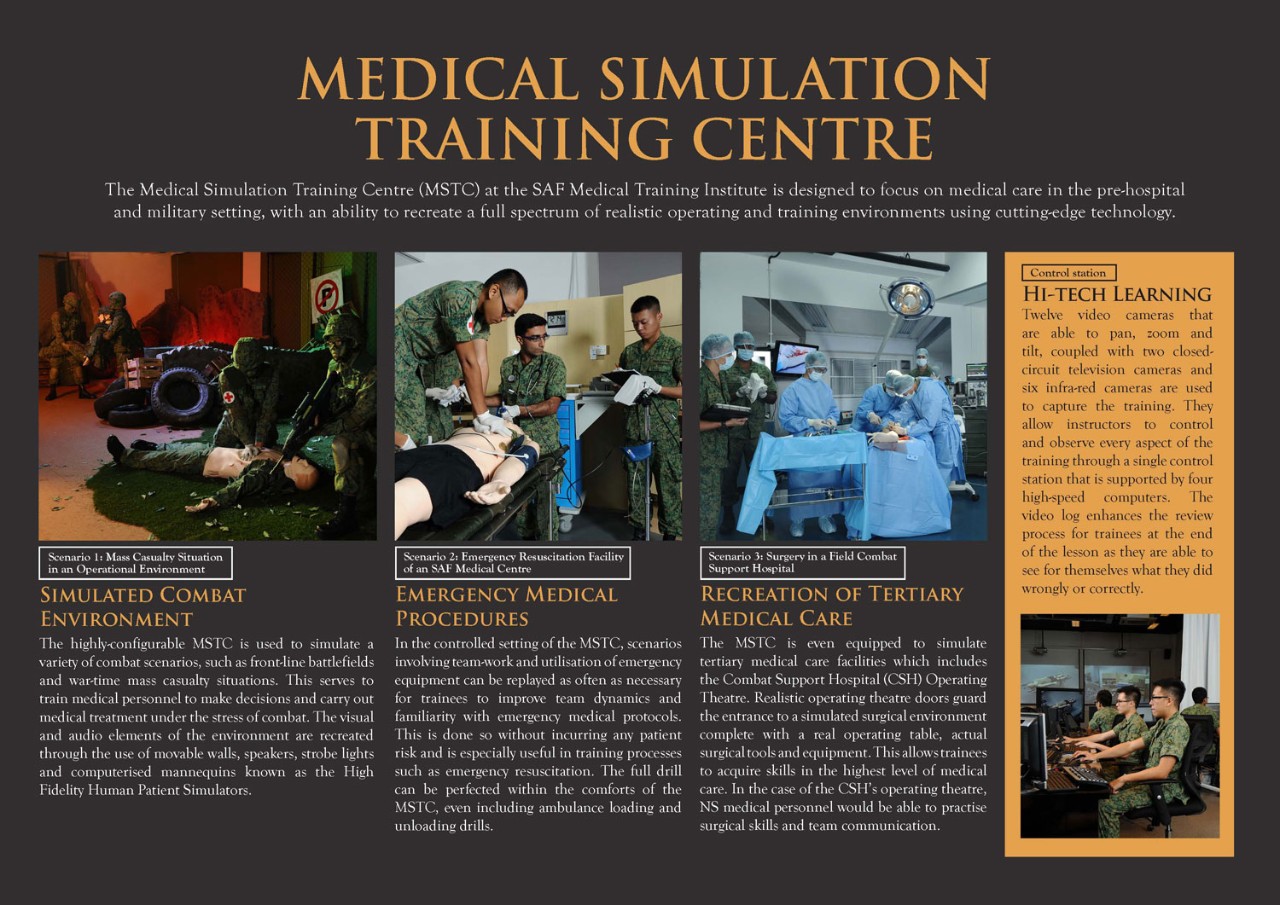 Medical Simulation Training Centre (MSTC)
Medical Simulation Training Centre (MSTC)
 Web Content Viewer
Web Content Viewer
 Medical Simulation Training Centre (MSTC)
Medical Simulation Training Centre (MSTC)
To meet the increasing complexity and broadening scope of paramedic practice against a backdrop of evolving operational environments, the SAF has established the MSTC to provide professional and effective training for our medical personnel.
Evolution of Medical Training in SMTI
Medical simulation training was first introduced as a training pedagogy in the SAF Medical Training Institute (SMTI) for SAF medical personnel in 2005. Following which, in July 2009, the 3rd Generation Army Medical Support System was launched. The system provided SAF doctors, nurses and medics access to the most advanced medical technology available to provide the best medical care for injured soldiers. As part of this new capability, a review and upgrading of the SAF paramedic training framework was also undertaken and this has led to the development of new courses which are designed to provide a continuum of increasing complexity and broadening scope of paramedic practice.
State-of-the-Art Features of the MSTC
In line with the evolution in medical training, the MSTC has been established to meet the training demands of the future. The key features of this centre are:
a) Environmental Realism. The 450m2 facility has configurable walls to create variable-sized operating environments and scenarios. These can range from the frontline in the battlefield, to the emergency resuscitation facility of a medical centre, the running track of an IPPT test area, or even an operating theatre of a field hospital. The centre has sound generators and strobe lights to make the simulated environment as realistic as possible. Training in the centre can proceed regardless of weather conditions and night conditions can be simulated.
b) Recording for Real-Time and Post-Activity Review. The MSTC is equipped with multiple video recorders that can pan, tilt and zoom to capture recordings under all lighting conditions. These recordings can be screened "live" in the Learning Room for other trainees who are not directly involved in the simulation exercise to observe the proceedings. This will allow learning to take place not only for the trainees in the exercise, but also for the observers who can partake in peer evaluation and critique. Post-activity, the instructor can also playback the positive and negative practices to reinforce teaching points. This process of experiential learning has been shown to encourage mastery of skills and retention of information.
c) Advanced High-fidelity Human Patient Simulators (HFHPS). The MSTC will also feature these computerised mannequins that can be programmed to exhibit advanced clinical signs that are not present in the first generation human patient simulators. These include eye pupillary reaction, bleeding limbs, bluing of the lips and tearing of the eyes, among others. This complements the new and revised curriculum of the Emergency Medical Technician (EMT) Course, which trains SAF medics in additional paramedic protocols including the ability to assess physical signs such as pupillary reflex, cyanosis and stridor (wheezing sounds). They also possess drug and event recognition as well as quality CPR feedback systems. In addition, these new HFHPS are mobile and wirelessly controlled, which allow for medical simulation to be conducted outside the classroom.
Usage of the MSTC and HFHPS
The MSTC and HFHPS are utilised for simulation training for the following purposes:
a) Training of new medical personnel. Medical personnel in the following entrance-level courses will benefit from the MSTC and HFHPS:
i. Emergency Medical Technician (EMT) Course. The EMT Course is a 12-week entrance-level course that all SAF medics are required to attend. The course emphasises simulation training and scenario practice in order to train medics in versatility and skills to cope with a wide range of medical conditions.
ii. Emergency Medical Specialist (EMS) Course. The EMS Course is a 12-week course that trains for more complex emergency scenarios. In addition to critical lifesaving skills, it also focuses on soft skills such as ambulance crew leadership, patient counselling and crisis management. It is conducted for Regular SAF medics.
iii. Medical Officer Cadet Course (MOCC). The MOCC is a three-month Course that is conducted for all Regular and NSF doctors. It builds on their current foundation in clinical medicine and further trains them in the unique disciplines of Military and Field Medicine to prepare them to function as SAF Medical Officers.
b) Training existing medical personnel. Regular SAF medics in the following courses as well as operationally ready national servicemen (NSmen) will benefit from the MSTC and HFHPS:
i. Primary Care Paramedic (PCP) Course. The PCP Course is a one-year part-time course that is designed for Regular SAF medics. Course content includes subspecialty topics such as pediatrics and obstetrics.
ii. Advanced Care Paramedic (ACP) Course. The ACP Course is a 15-month full-time advanced Diploma programme that is designed for Regular SAF medics. Course content includes advanced life support, pre-hospital system management and medical research and development.
iii. NS Medical and Surgical Units. NSmen doctors and medics serving in the Medical Company, Mobile Surgical Team and Combat Support Hospital will undergo integrated training at the MSTC, where they will participate in simulation exercises together. This is essential for the training of communication and teamwork between individuals and groups, as doctors and medics often have to work alongside each other in real life.
c) Equipping soldiers deployed for overseas missions. The MSTC and HFHPS are also used to train soldiers during the pre-deployment phase, to better prepare them for the scenarios and environments that they are likely to encounter during their overseas operations.
